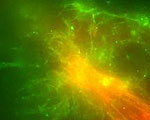Nano-Shuttles Built Their Own Tracks for Localized Delivery
 Nov-13-13
Tiny shuttles the size of molecules able to build their own tracks could be used to transport medicine or molecular materials to specific locations in the body.
Nov-13-13
Tiny shuttles the size of molecules able to build their own tracks could be used to transport medicine or molecular materials to specific locations in the body.The system, developed by a team from Oxford University, is built from DNA and kinesin, a motor protein. By putting two kinesins together, the team created an ‘assembler nanobot’ that built micro-tracks out of strands of artificial, non-living DNA. Triggering the assemblers with ATP (adenosine triphosphate), which cells use to transport energy, prompted the proteins to arrange the tracks in the shape of spokes.
In tests, ‘shuttles’ made of kinesin molecules were loaded with a fluorescent green dye and sent in to the system, where they placed themselves evenly along the track. Adding more ATP caused the shuttles to cluster at the ‘hub’ of the track, and then signal shuttles were sent in to tell the cargo shuttles to release the dye, which dispersed evenly in the target location. According to the research team, the dye used in the test could be replaced with most any other compound.
More Info about this Invention:
[DISCOVERY.COM][UNIVERSITY OF OXFORD]

Add Your Comment